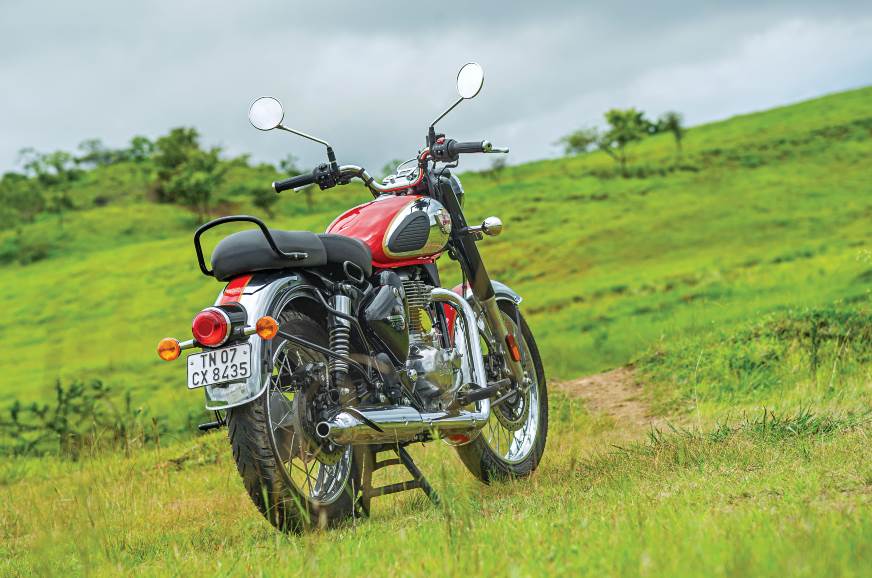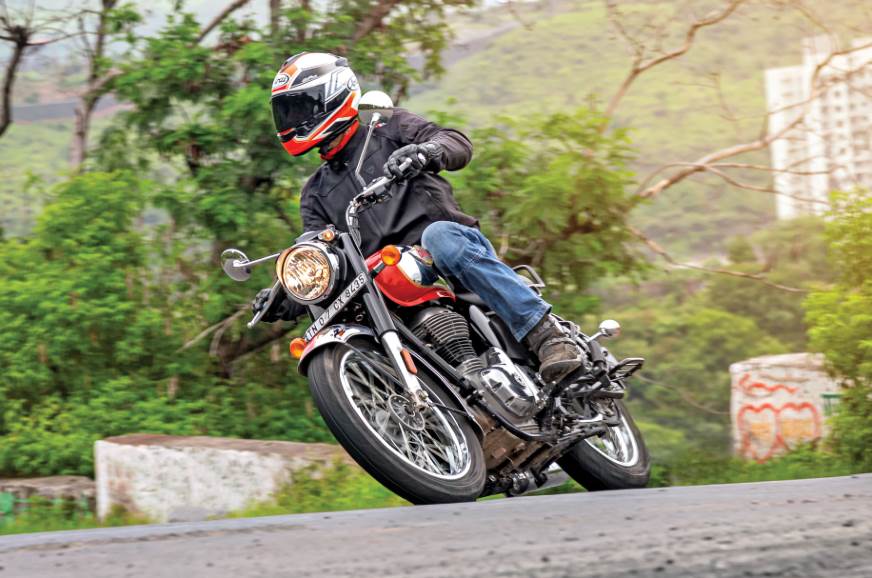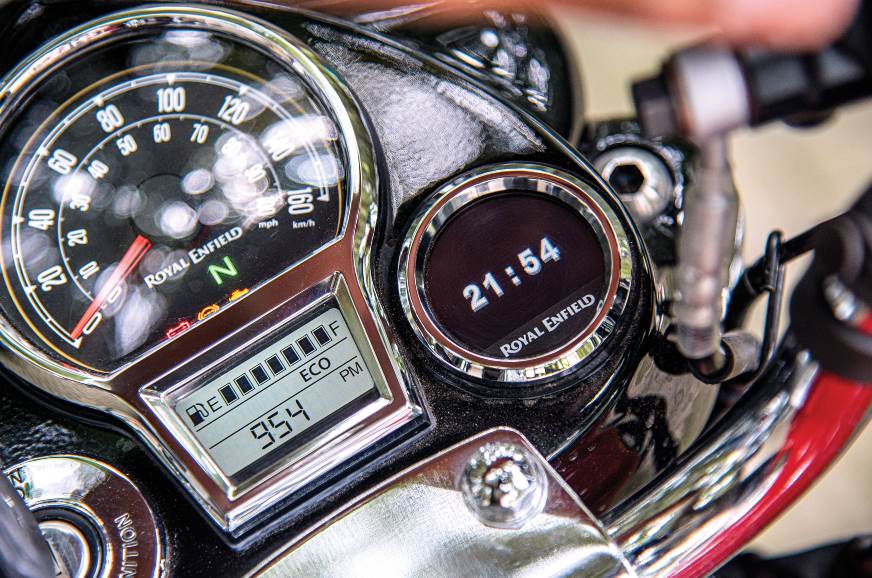No one really likes working on Sundays. However, there are things that promise to motivate and at this point, you’d expect me to say somethi...
No one really likes working on Sundays. However, there are things that promise to motivate and at this point, you’d expect me to say something cliche like a hot cup of coffee and the love for motorcycles. Nah, that’s not stopping me from playing the latest Assassin’s Creed. What is, is the fact that life has kind of come full circle with this review that I’m working on over the weekend. Growing up, my father would take me for a spin on either his cast-iron Bullet 350 or diesel-powered Taurus and he’d tell me all about what made them special and how they felt to ride. And now, 20 years later, it’s my turn to do so, but with Royal Enfield’s all-new Classic 350.
Design
Let’s be real, if not for this gorgeous red and chrome colour scheme, it’d be rather difficult to tell that this is the brand-new Classic from even a couple of bike lengths away. That’s funny because the truth is that every single panel and surface on this motorcycle is new and there are no part carryovers from the old Classic.
Manufacturers often refrain from messing with fundamental design elements of their most sought-after offerings, but, in this case, they’ve gone the extra mile and held themselves back from even making any changes that could alter the overall look. And to be honest, can you blame them? Firstly, this is a design that changed the very destiny of Royal Enfield. Secondly, and more importantly, it’s already so damn good-looking.

Smaller, neater taillight and indicators much better than before.
What Royal Enfield has used this opportunity to do is to make a big improvement in fit and finish, and overall quality of components. The first things you’ll notice are the updated switchgear cubes, levers, balloon-grips and neat bar-ends. The switchgear cubes are identical to the ones on the Meteor 350, and they look and feel vastly superior to the ones they replace. That said, we wish the pass-light switch was slightly easier to operate. The non-adjustable curvy levers, meanwhile, look like they belong on this bike. However, they are quite thick, which makes grabbing them a little difficult, and riders with smaller hands will end up straining their fingertips under heavy usage. The balloon grips and bar-ends look expensive and are hard to fault.
Another nice touch comes in the form of the fuel-filler cap that sits a lot more flush. Royal Enfield has redesigned other points that you’d touch as well. The foot pegs, for instance, look top-notch and the seat is more supportive. The company has also ditched the twin-spring set-up under the rider’s seat for a fixed cantilever mount, thus keeping you from floating around in the corners. If you were a fan of the old-school look of the springs, worry not as you can buy some aesthetic springs as an official accessory.
They’ve also finally gotten rid of the hideous tail-light and number plate assembly and opted for a much more simple set-up. This has really tidied-up the rear of the motorcycle. Speaking of tidying-up, for 2021, the bike has much neater welds, uniform usage of Allen bolts and no exposed wires. This level of detail is a clear indicator that the company is also targeting more-developed global two-wheeler markets, just like they did with the Meteor 350.
Performance
The 2021 update also sees the 346cc UCE’s departure, and in its place comes the ‘J-platform’ 349cc engine. This engine is identical to the one that made its debut last year on the Meteor 350, but Royal Enfield has said that the one on the Classic has its own ignition timing, exhaust layout and fueling map. Map? That’s a word my father never used to describe his Royal Enfields. There are many who won’t agree with the use of the modern tech on the Classic, but everyone needs to move with the times and all I have to say is don’t knock it until you’ve tried it.
The old Classic’s pushrod-valve system is replaced by a SOHC two-valve head, and while the engine remains air-cooled, there is an additional internal oil circuit within the cylinder head to aid cooling. The new engine has an increased bore, by 2mm, and a reduced stroke, by 4.2mm, while also gaining a primary balancer shaft. Like with the Meteor 350, these changes were made to increase the usable range of torque, while simultaneously stamping out the off-putting high-RPM vibrations, and the results are quite evident.

It doesn’t thump like an old cast iron Bullet, but still feels like an RE motor.
Royal Enfield wasn’t after performance numbers while designing this engine, but it still gets the Classic to 60kph in 5.25sec and 100kph in 16.23sec, whereas the outgoing one does it in 6.49sec and a lethargic 25sec, respectively. What Royal Enfield enthusiasts will appreciate the most though is that the engine still oozes character. Yes, it doesn’t have the loud thump of the older engines, but it still has a sweet-sounding exhaust note. It’s also quite unique in the way it builds speed and, as you go off the throttle, loses it. Royal Enfield has made sure that the engine braking is very controlled, and that fueling isn’t cut abruptly as you go off throttle, so as to give the bike gradual deceleration.
This is also the first Classic that can sit at around 95-100kph without feeling like it’s coming apart. I would go so far as to say that this bike performs better than my old UCE Classic 500 in every single way. The 5-speed gearbox is smooth and works well with this motor, but the clutch feels heavy, especially in bumper to bumper traffic.
The 2021 Classic doesn’t leave the same long-lasting impression when it comes to the fuel efficiency numbers. At 32.7kpl (city) and 36.7kpl (highway), it delivers similar results as the older one on the highway, but a slightly lower figure in the city.

Added ground clearance and more suspension travel means its even more ready for a trip to Ladakh, or a bit of fooling around off-road!
Ride & Handling
Royal Enfield has also made big improvements in the chassis department. The biggest change comes in the double-downtube frame that replaces the basic single-cradle unit. While the main frame and swingarm are exactly the same as on the Meteor, the foot peg mounts are different, as is the rear subframe which enables the mounting of a different rear fender. Like with the Meteor 350, the ground clearance on the 2021 Classic 350 has climbed by 35mm, to a fairly substantial 170mm. As a result, there’s a big bump in cornering clearance as well.
While the suspension components might look the same as before, Royal Enfield has said that they aren’t and the new Classic gets a fatter 41mm telescopic fork. Even when compared with the Meteor, the Classic gets a little more damping, which results in a slightly firmer ride.

Handling is vastly improved with more feel and cornering clearance available to the rider.
The bike has a relatively firm feel to the ride quality, but it’s not harsh or too stiff. What has come as a by-product of this suspension set-up is much more confident handling. That being said, it still doesn’t feel as agile and light on its feet as the Meteor 350. The different wheel and tyres sizes, as well as the different rider ergonomics, are probably the reasons for this. While the 2021 Classic 350 continues to use a 19-inch (front)/18-inch (rear) wheel set-up, the Meteor comes equipped with a 19-inch (front)/17-inch (rear) combination. These wheels come wrapped in a 100/90 tyre at the front and 120/80 section tyre at the rear. The Ceat tyres it comes equipped with behaved quite well in the rain.
Anchorage comes from a 300mm front disc and a 270mm rotor at the rear with dual-channel ABS – although there is a base model with a rear drum brake and single-channel ABS. Braking performance is good with a heavy pull, but the front brake feel is dull, just like the Meteor’s. Despite this, the 2021 Classic 350 managed to get from 60-0kph in 16.47m, which isn’t only better than the outgoing model, but also respectable when you consider its heavy, 195kg kerb weight.
Features
Classic 350 owners will no longer get ridiculed for not having a fuel gauge. The latest update has added a small LCD below the analogue speedometer that displays the odometer, two trip metres and the long overdue fuel gauge. While the LCD is a nice touch, the updated analogue speedometer, with its glowing needle, looks a bit too modern. The conventional needle and white face of the older bike looked more appropriate.
The top-spec Chrome variant also gets the company’s Tripper navigation display as an optional extra. It will also be available as an MIY accessory for the lower models in the coming months. It takes the low fuel light gauge’s place on the older bike, which means it doesn’t stick out or look out of place. Using Google Maps data, this system works when connected to the Royal Enfield app, and we found it to be quite intuitive and helpful. However, it doesn’t give you any call or SMS related notifications. It’s also hard to read with the sun right overhead. If you decide not to use Tripper navigation, this display will simply show you the time.

The Classic 350 finally gets a fuel gauge along with two trip metres on the new LCD display.
The company has said that it will offer Tripper navigation as an optional accessory on the lower-spec models in a few months’ time, when semi-conductor related supply improves. There’s a neat USB charging socket underneath the clutch lever’s mounting point, but that’s where the features list ends.
Royal Enfield has realised that its buyers like to personalise their motorcycles, which is why the
Classic 350 will have a number of accessories available straight from the factory. With the help of the online configurator, buyers will be able to choose from a number of accessories, including different alloy wheels, exhausts and seat options. The company will also be offering a lower seat option that reduces the 805mm seat height by 32mm.
Verdict
With its familiar looks, it may not look like it, but the engineers at Royal Enfield have done as much as they could while not messing with what gets them the nutty sales numbers. When compared to the outgoing model, it has major improvements to the engine, frame, suspension and brakes, but without compromising on the feel that customers will expect. They’ve also added a couple of features and improved the fit and finish, while they were at it. With a starting price of Rs 1.84 lakh the single channel ABS-equipped Redditch variant is competitively priced. The Halcyon, Signals, Dark and Classic Chrome variants are progressively more expensive. The good thing is that from the Halcyon onwards, underneath the skin, all the models are more or less the same. As a package, the Classic 350 has been modernised and improved in almost every way. However, RE has also managed to retain the virtues that Classic fans tend to love and that makes this motorcycle a safe, yet worthy successor to the original.